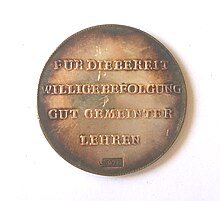Kleetaler

The Kleetaler (also known as Kleethaler in the old spelling ) is a taler-shaped reward medal from the last decade of the 18th century that was minted in Erbach in the Odenwald. Sometimes it is also referred to as a foam coin . It was given to farmers in the Odenwald to promote the cultivation of clover and, due to its rarity, it achieves high prices at numismatic auctions today .
background
Count Franz I. zu Erbach-Erbach had known the problems of the Odenwald agriculture in his county since he took office in 1775 . Especially at high altitudes, the cattle were not adequately supplied with green fodder , as the soil there could not provide enough hay due to the thin humus cover over the supporting sandstone . On his second educational trip, his path also took him to Berlin . There he learned both the most important agricultural reformer of his time - Johann Christian Schubart - and his work "Well-intentioned acclamation to all farmers who suffer from lack of fodder, especially the Electoral Saxons. In addition to well-established instructions on how they can easily and frequently get there, consequently also wealthy can be. " , first printed in Leipzig in 1784. Schubart's findings on soil improvement, but especially the advice to use red clover - Trifolium pratense - as a forage plant for barren soils , met with his approval. Red clover can not only be used as green fodder, but as a plant it also improves the soil at the same time. After his return to Erbach, he wanted to see the cultivation of clover enforced as widely as possible. It was clear to him, however, that due to the events of the French Revolution since 1789, such a project would not be forced to do so. Hence his idea of rewarding the Odenwald farmers - who are traditionally very critical of innovations in themselves - for following his advice with the “Kleetaler”.
Embossing and appearance
The design for the taler-shaped medal, which was never intended to be used as a Kurant coin , was provided by the Prince of Löwenstein-Wertheimische Münzwardein Karl Stockmar, who also supervised the minting. The medal was minted in 1793 in silver with a weight of about 28 grams , according to other literature with a weight of two inches per inch (33.332 g coin weight and thus a fine club thaler). The diameter is 37.5 millimeters and has a ribbed edge.
On the obverse there is a shamrock in the lower third, below on the right a plowing farmer. On the left side, next to a hint of the Mümling river , in the middle of a wooded, rising mountain slope is a representation of the Count's Castle Erbach . A village is indicated between fields on the right. A rising, forested mountain slope can be seen again, as well as a rising sun above it. The inscription reads: ICH SELBST BELONE AM BESTEN , the year at the bottom in Roman numerals MDCCXCIII, i.e. 1793.
On the lapel is the four-line inscription FOR READY / WILLING FOLLOW-UP / WELL MEANED / TEACHING .
The exact number of clover thalers minted is unknown, they are considered very rare today. The medal was awarded to the peasants either by the Count himself or by the local pastor on the basis of a suggestion and the following approval by the Count , the vast majority of which is still privately owned by the heirs of those who have been awarded it.
In 2009, the starting price of one of the few Kleetaler up until then for sale at a coin auction was 7,500 euros.
literature
- Friedrich Höreth: Der Kleethaler des Count Franz in: (ders.): History and stories from the Odenwald , published by the district committee of the Odenwaldkreis, Volume I, 3rd edition, Erbach (Odenwald) 1985, pp. 25-26
- Johann Philipp Ernst Ludwig Jäger: The agriculture and forestry of the Odenwald. A winning prize publication , Verlag Carl Dingeldey, Darmstadt 1843, p. 80 ff.
- Voices of wisdom from earlier and more recent times in the area and for the appreciation of agriculture , G. Jonghaus's court bookstore, Darmstadt 1854
- Paul Otto: The history of the Grand Ducal Hessian Hofmeiereigüter zu Darmstadt, Gehaborn and Kranichstein with special consideration of cattle breeding , M. Rummel, Darmstadt 1924
Individual evidence
- ↑ Heinz Fengler, Gerd Gierow, Willy Unger: transpress lexicon Numismatics , Berlin 1976
- ^ Hessian agricultural journal ; more precisely: Journal for the agricultural associations of the Grand Duchy of Hesse , 33rd year, Darmstadt 1863, p. 232 ( Googlebooks )
- ↑ Künker auction catalog No. 154 , accessed on June 28, 2015


